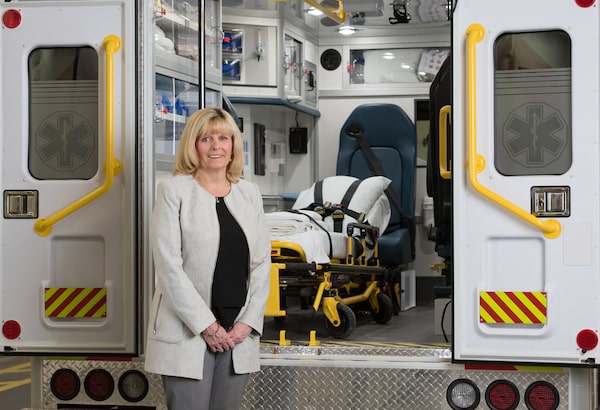Paula Poirier became vice-president of Emergency Medical Services operations at Medavie Health Services in Ontario in 2012 and chief operating officer of Nova Scotia’s Emergency Medical Care (EMC) in 2009.

Paula PoirierMichelle Doucette
Currently, I run four companies, two in Ontario in Chatham-Kent and Elgin County. In Nova Scotia, we run the paramedic and air ambulance system, also now Telehealth, totalling 1,636 staff. In July, I’ll be transitioning Medavie EMS Ontario into a restructuring.
Some people don’t see it as running companies − don't differentiate between running businesses to running emergency health services (EHSs). My background is a culmination. Mind you, you wouldn’t want me to take care of you now, but I understand the world, the lingo.
I come from a family with seven children in a small Cape Breton mining town, the third nurse. I wanted to go into teaching. I like to work with people, help, so around Grade 11, thought I’d like nursing.
I started in general surgery and orthopedics. I liked the fast pace – something new all the time. When I graduated we had to wear nurses’ caps, so I went into emergency as I didn’t have to wear it there – perfect!
I managed a general surgery floor, then surgical and medical intensive care units (ICU). When the hospitals amalgamated, I moved three ICUs to the new hospital.
I did my masters in nursing from Dalhousie University while working full-time, my thesis was on change management and the move. A director went on maternity leave in cardiac emergency and thoracic; I ran that. There was an advertisement for a trauma co-ordinator for Nova Scotia’s first program. I wanted to get in on the ground level. I was there a few years, started a co-ordinators group, then asked the all-physician Trauma Association of Canada to be part of them – including everyone across the spectrum. They said, “Sure, come on board.” I was the association’s first non-physician president. I brought what I learned from business to the association, whereas when I started out, it was more clinical.
I was the director for Nova Scotia’s EHS programs for nine years, in the system before 1997 so saw the 52-plus ambulance operators – many in funeral homes – with little or no standardization in vehicles, equipment.
People worked behind the scenes to rebuild the system. Twenty years later, it’s a transformation. I’m certainly proud of the system’s evolution and transformation. I helped build it, but I help run it. A lot of people wouldn’t know one company runs day-to-day operations. From being transactional in silos, today it’s co-ordinated and integrated in all aspects.
Most leaders I work with don’t have a health background, and vice versa, I learn from them in business.
I love the vision-making changes, being innovative, part of solutions and helping the system. I like to keep busy, be informed, but I like people to know they have to do their job. Because of technology, I can do it anywhere; I’m always available. I go to Ontario at least once a month, on the phone at least weekly with my two general managers. One thing I really like about working for Medavie is that it’s a not-for-profit. Profits go to the Medavie Foundation for grants.
I’m proud of my career path: I came from a front-line clinician to being in a business and leadership position.
My parents always supported us for education, so I’ve always supported education and staff who wanted to go into leadership. Where I come in is building my team, having experts. I like to give people leverage so they can make decisions.
What do you want to do in five years time? I want to hear what they say first, then ask how I’m going to get them there. I ask if they want to be in my job; people push back a bit because they don’t want to say they want my job, but the next two or three years are going to come whether you like it or not.
The best advice is from my parents: treat people how you want to be treated, everybody’s part of the puzzle to make it work. There’s a solution for every problem. My children don’t even try to articulate what I do. I try to explain that sometimes a career path – how things change – can take it a different way.
This interview has been edited and condensed.
We’ve launched a new weekly Careers newsletter. Sign up today.